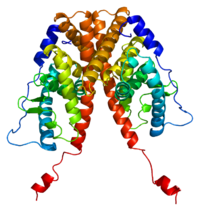
Photo from wikipedia
Cardiovascular (CV) and renal diseases are increasingly prevalent in the United States and globally. CV-related mortality is the leading cause of death in the United States, while renal-related mortality is… Click to show full abstract
Cardiovascular (CV) and renal diseases are increasingly prevalent in the United States and globally. CV-related mortality is the leading cause of death in the United States, while renal-related mortality is the 8th. Despite advanced therapeutics, both diseases persist, warranting continued exploration of disease mechanisms to develop novel therapeutics and advance clinical outcomes for cardio-renal health. CV and renal diseases increase with age, and there are sex differences evident in both the prevalence and progression of CV and renal disease. These age and sex differences seen in cardio-renal health implicate sex hormones as potentially important regulators to be studied. One such regulator is G protein-coupled estrogen receptor 1 (GPER1). GPER1 has been implicated in estrogen signaling and is expressed in a variety of tissues including the heart, vasculature, and kidney. GPER1 has been shown to be protective against CV and renal diseases in different experimental animal models. GPER1 actions involve multiple signaling pathways: interaction with aldosterone and endothelin-1 signaling, stimulation of the release of nitric oxide, and reduction in oxidative stress, inflammation, and immune infiltration. This review will discuss the current literature regarding GPER1 and cardio-renal health, particularly in the context of aging. Improving our understanding of GPER1-evoked mechanisms may reveal novel therapeutics aimed at improving cardio-renal health and clinical outcomes in the elderly.
Journal Title: Biomolecules
Year Published: 2022
Link to full text (if available)
Share on Social Media: Sign Up to like & get
recommendations!